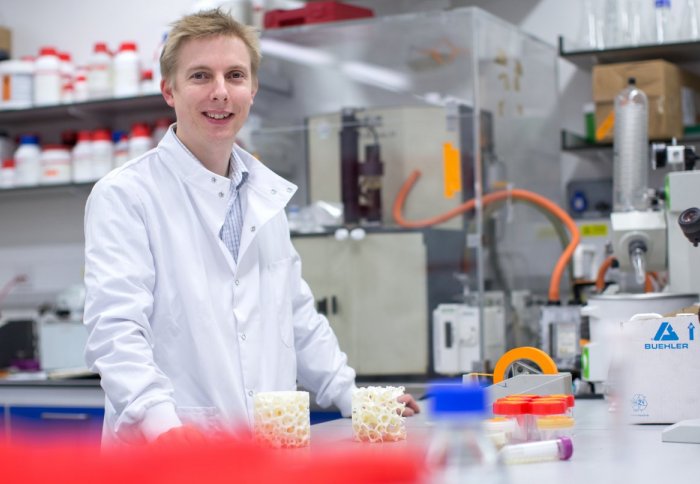
Cartilage is flexible connective tissue found in places such as in joints and between vertebrae in the spine. Compared to other types of connective tissue is not easy to repair.
In the computer animation (left), the team show how a scaffold could be implanted behind the knee to encourage cartilage cells to
The researchers from Imperial College London and the University of
In the video below the researchers demonstrate the
They believe it also has the potential to encourage cartilage cells to grow in knees, which has previously not been possible with conventional methods.
The
It also displays
The researchers in the video below demonstrate how the
One formulation developed by the team could provide an alternative treatment for patients who have damaged their intervertebral discs. When cartilage degenerates in the spine it leaves patients with debilitating pain and current treatment involves fusing the vertebrae together. This reduces a patient’s mobility.
The scientists believe they will be able to engineer synthetic
Another formulation could improve treatments for those with damaged cartilage in their knee, say the team. Surgeons can currently create
The team are aiming to ‘print’ tiny, biodegradable scaffolds using their
When implanted, the combination of the structure, stiffness and chemistry of the
Professor Julian Jones, one of the developers of the
«Patients will readily attest to loss of mobility that is associated with degraded cartilage and the lengths they will go to try and alleviate often excruciating pain. We still have a long way to go before this technology reaches patients, but we’ve made some important steps in the right direction to move this technology towards the marketplace, which may ultimately provide relief to people around the world.»
The researchers have received funding from the Engineering and Physical Sciences Research Council to take their technology to the next stage. They are aiming to conduct trials in the lab with the technology and develop a surgical method for inserting the implants. They will also work with a range of industrial partners to further develop the 3D manufacturing techniques.
Professor Justin Cobb is the Chair in Orthopaedic Surgery at Imperial’s Department of Medicine. He will be
Professor Cobb added: «This novel formulation and method of manufacture will allow Julian and his team to develop the next generation of biomaterials. Today, the best performing artificial joints are more than a thousand times stiffer than normal cartilage. While they work very well, the promise of a novel class of bearing material that is close to nature and can be 3D printed is really exciting.
«Using Julian’s technology platform we may be able to restore flexibility and comfort to stiff joints and spines without using stiff metal and all its associated problems.»
Professor Laura Cipolla, from the Department of Biotechnology and Biosciences at the University of
The team also includes PhD student Francesca Tallia from Imperial’s Department of Materials and senior researcher Laura Russo, from the Department of Biotechnology and Biosciences at the University of
The technology still has a number of regulatory hurdles to overcome before it reaches clinical applications for both applications. The team predict it will take ten years to for both technologies to reach the market. They have patented the technology with Imperial Innovations — the College’s technology commercialisation partner.
Source: http://www3.imperial.ac.uk/newsandeventspggrp/imperialcollege/newssummary/news_12-5-2016-9-57-13


